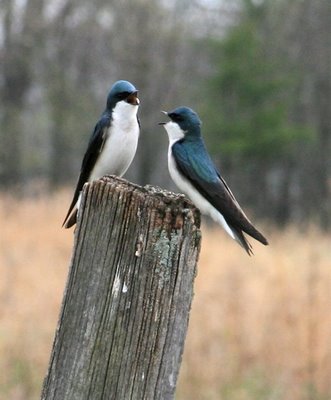 I don't have a great big long lens--only 300 mm, handheld. What I do have is ridiculously tame tree swallows. Think they know who got rid of the house sparrows in their box? You bet they do. The female won't even budge off her eggs when I open the box. I have to lift her up to count them.
I don't have a great big long lens--only 300 mm, handheld. What I do have is ridiculously tame tree swallows. Think they know who got rid of the house sparrows in their box? You bet they do. The female won't even budge off her eggs when I open the box. I have to lift her up to count them.Nothing good comes without passion and hard work, I think. Well, duh, I don't think that. Lots of good things happen unbidden. Sure they do. But if you want nice birds nesting in your boxes, and you have a plague of house sparrows around, you've got your work cut out for you.
We don't usually have house sparrows around this place. But last spring I wanted to paint a brood of baby house sparrows from life, and I figured it was worth letting them nest in a bluebird box, just this once, for the painting. It's a great painting. It was worth it. What I didn't bet on was that when that brood fledged, the pair would sneakily set up a second brood in our big bluebird roost box, which can't be opened, and raise that one, too. Before you knew it we had nine to fourteen of the freakin' things chirrupping around here every morning, stuffing themselves with suet dough, and stuffing the bluebird boxes with weed stems and feathers. Oh, man, what a bed I made for us.
So I went rummaging around in my bluebird supplies in the basement and garage and miraculously found a small white sealed envelope. I opened it up and found a Gilbertson in-box sparrow trap. What are the odds. I didn't even know I had it; I was looking for the Huber in-box trap I had years ago and have since misplaced. Nothing's ever truly lost when you own as much krap as we do; it just gets covered over. Steve must have sent it to me as a gift when I ordered the last case of 14 Gilbertson PVC bluebird boxes from him. Not only is he a genius, he's a really nice guy, too.
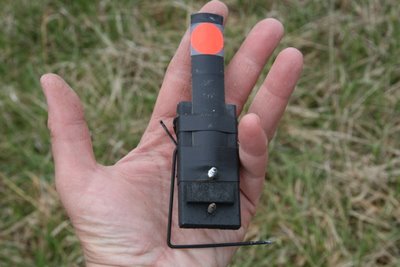 This has to be one of the neatest and best little inventions ever, made by my friend Steve Gilbertson, he of Gilbertson PVC bluebird box fame; he of the Gilwood box (a fabulously well-designed wooden bluebird nest box). It's simple, but man, does it work well. You mount it with a couple of screws on the inside front door of the box, so when it's tripped, the little tongue of flexible but strong plastic flips up and covers the entrance hole. The treadle, which looks like a wire L in this shot, hangs down over the nesting material, and the bird lands on it when it enters the box. Here , the trap is set, ready to spring when I close the box and a bird lands on the treadle.
This has to be one of the neatest and best little inventions ever, made by my friend Steve Gilbertson, he of Gilbertson PVC bluebird box fame; he of the Gilwood box (a fabulously well-designed wooden bluebird nest box). It's simple, but man, does it work well. You mount it with a couple of screws on the inside front door of the box, so when it's tripped, the little tongue of flexible but strong plastic flips up and covers the entrance hole. The treadle, which looks like a wire L in this shot, hangs down over the nesting material, and the bird lands on it when it enters the box. Here , the trap is set, ready to spring when I close the box and a bird lands on the treadle.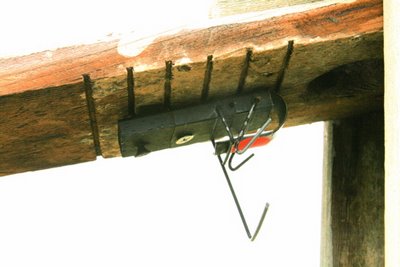
 When you see the orange dot in the hole, you've got a customer inside.
When you see the orange dot in the hole, you've got a customer inside.A trap like this is non-specific; it will catch whatever bird enters the box. But neither does it hurt the bird. The only thing you must be sure of is that you check it frequently, at least every three hours. I check it every half-hour. I've caught a bluebird and a Carolina chickadee this week, and they were only confined a matter of minutes before I ran up to release them. I've also caught seven house sparrows in two weeks. They were not released.
I've made dozens upon dozens of trap runs to four different far-flung bird houses on our property, but it's been worth it. We're down to one male house sparrow on the place, and he's real lonely. I hope he'll bug off soon. Why do I do it? Because the house sparrow infestation is a problem of my own making, one that threatens to negate the 15 years of good work building bluebird and tree swallow and Carolina chickadee populations on our farm. If I let them reproduce in my boxes, before long all I'll be producing is house sparrows, an imported Eurasian species that kills native nesting birds. And I do it so, instead of a scruffy house sparrow, I can see this sitting on my bluebird boxes:
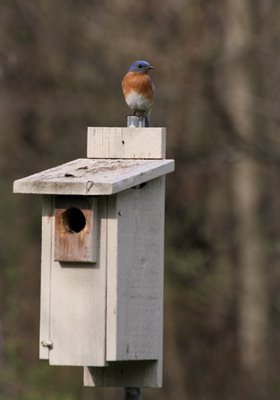 And this sitting on the perch post beside a box where I've trapped two house sparrows:
And this sitting on the perch post beside a box where I've trapped two house sparrows: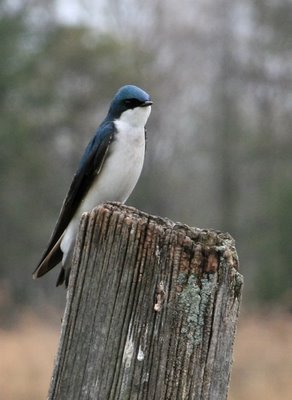 And the lovely tree swallow and his mate, having an animated conversation about the new house that just opened up. This may be the only kind of bigotry that's really justifiable.
And the lovely tree swallow and his mate, having an animated conversation about the new house that just opened up. This may be the only kind of bigotry that's really justifiable.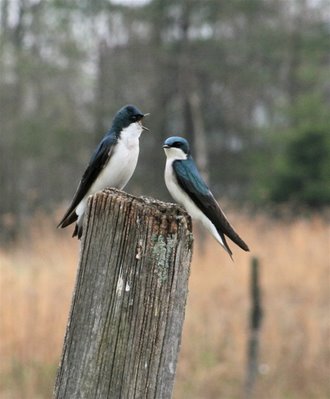






0 comments:
Post a Comment